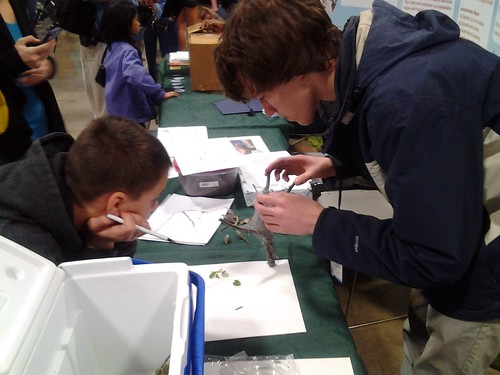
This post is part of the Science Tuesday feature series on the USDA blog. Check back each week as we showcase stories and news from the USDA’s rich science and research portfolio.
When you think of agriculture do you think of science and engineering? You should! Farmers are some of our original scientists, tinkering with plant varieties and farming techniques to find ways to reliably grow food. At USDA, we still do that kind of research in a never-ending effort to find better ways to produce food, fuel, and fiber. We also do a lot of research you might not think of when you think about agriculture: from forensic genetic analysis to track down unwanted pests to figuring out how to turn spent grain from distilleries into biodegradable kitty litter.
On April 26-27, the 3rd Annual USA Science and Engineering Festival took over the Walter E. Washington Convention Center in Washington, D.C. Over 325,000 people came out to celebrate discovery and innovation through over 3,000 hands-on activities and 150 performances and lectures. USDA pulled all of the stops to show our geeky side and hopefully convince a few young booth visitors to consider agriculture when they think about careers in science.
USDA showcased a topic near and dear to agriculture: invertebrates (Geeky sidebar: the scientist in me, to be truly taxonomically accurate, is using the term “invertebrates” instead of “insects” because I need to talk about worms below, and worms are not technically insects.). In addition to a worm composting demonstration, USDA’s very own Sonny Ramaswamy, National Institute of Food and Agriculture director and entomologist, helped kids learn about common insects in their environment with hands-on demonstrations. Our effort to get visitors interested in insects was also functional to our Agency mission: the part of our booth coordinated by the Animal and Plant Health Inspection Service taught booth visitors how to identify invasive insect pests that threaten agriculture so they can avoid spreading them and report them when they see them.
For those not inclined to spend time with creepy-crawlies, USDA also offered activities in a mobile laboratory to learn about food safety, the chance to learn to identify leaves from common plant species, and an opportunity to interact with a working model of a weather station to see how USDA collects the temperature, wind, and rainfall data that helps our nation’s farmers and land managers make decisions.
The event was a big success for agriculture thanks to the dedication of our agencies. Looking forward to seeing you next year!

